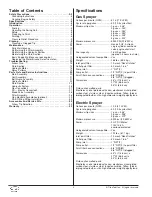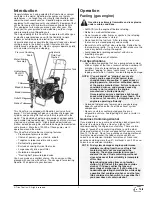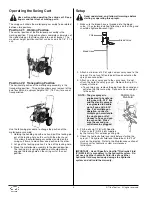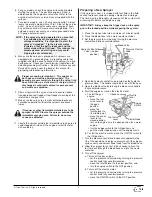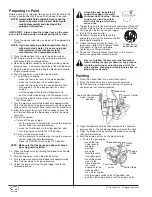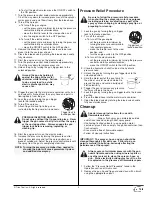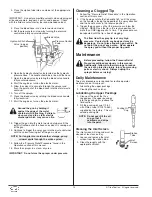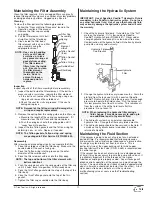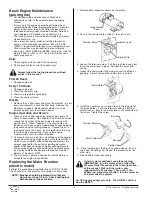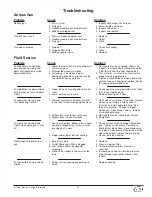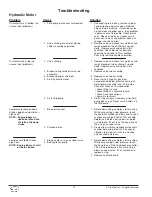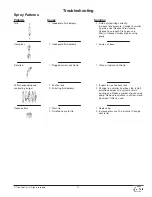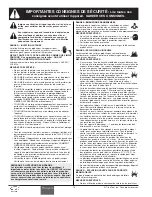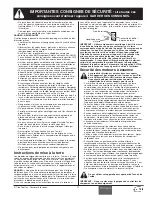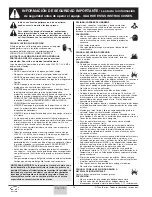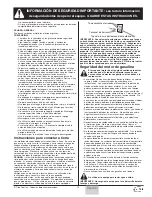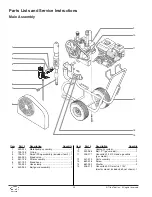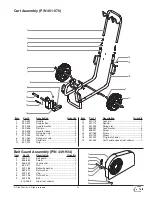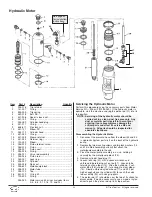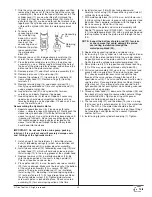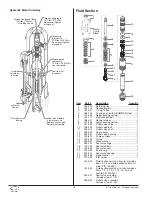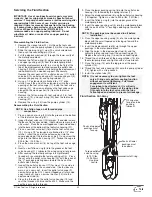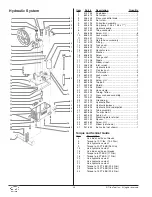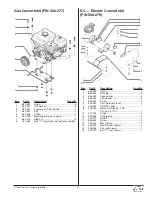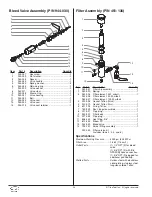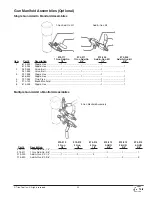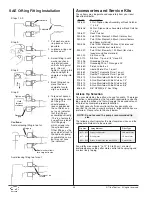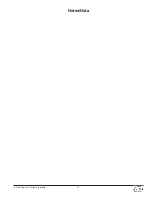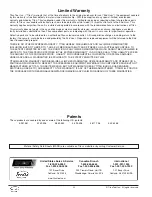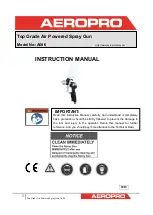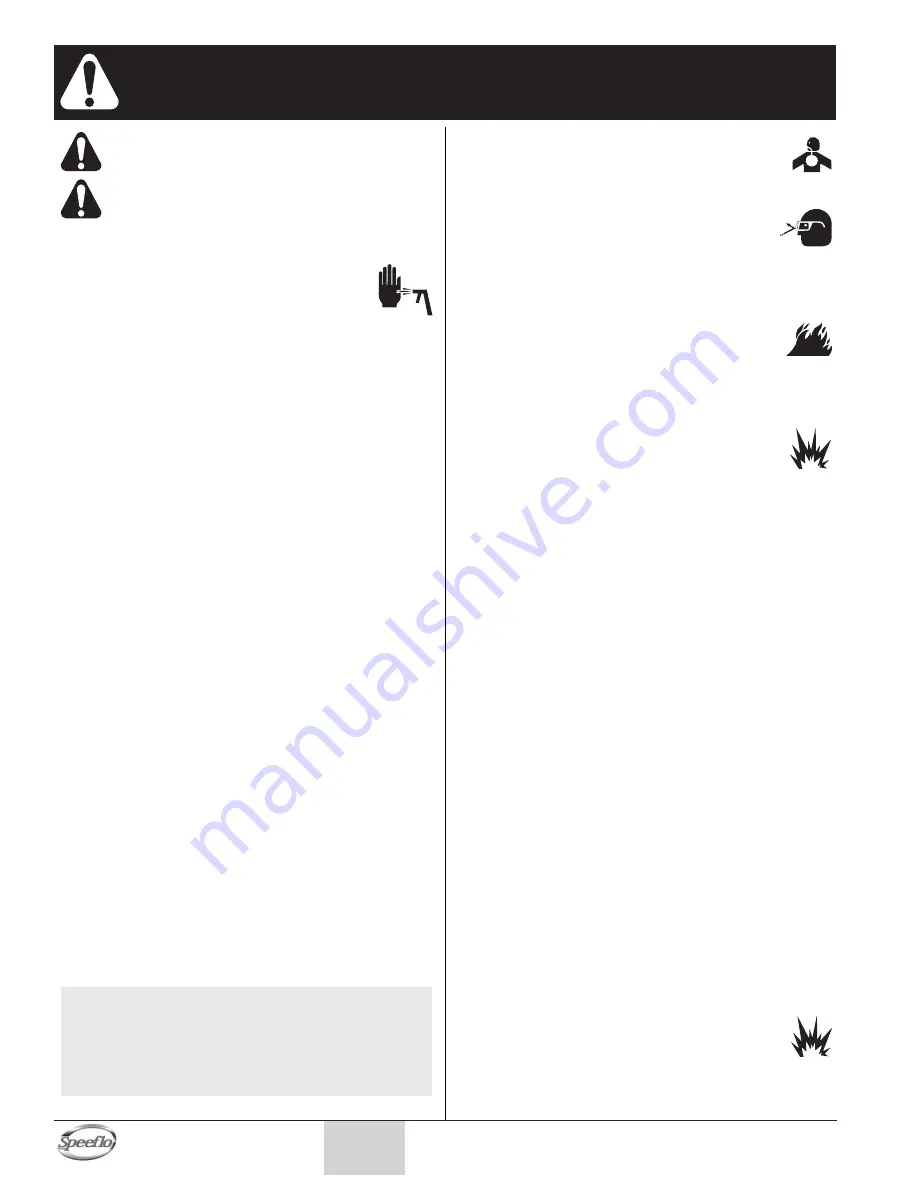
18
© Titan Tool Inc. Todos los derechos reservados.
Español
INFORMACIÓN DE SEGURIDAD IMPORTANTE
• Lea toda la información
de seguridad antes de operar el equipo. GUARDE ESTAS INSTRUCCIONES.
Indica una situación peligrosa que, de no evitarse,
puede causar la muerte o lesiones graves.
Para reducir los riesgos de incendios, explosiones,
descargas eléctricas o lesiones a las personas, lea y
entienda todas las instrucciones incluidas en este man-
ual. Familiarícese con los controles y el uso adecuado
del equipo.
PELIGRO: LESIÓN POR INYECCIÓN
El flujo de pintura a alta presión que produce este equipo
puede perforar la piel y los tejidos subyacentes,
ocasionando lesiones graves y posible amputación.
CONSULTE A UN MÉDICO INMEDIATAMENTE.
¡NO TRATE LA LESIÓN POR INYECCIÓN COMO UNA
CORTADURA SIMPLE! La inyección puede ocasionar
amputación. Consulte a un médico inmediatamente.
La gama operativa máxima de la pistola es de 3300 PSI / 22.8 MPa
de presión del líquido.
PREVENCIÓN:
• NUNCA apunte la pistola a ninguna parte del cuerpo.
• No apunte con la pistola ni rocíe a cualquier persona o animal.
• NUNCA deje que ninguna parte del cuerpo toque el flujo de
líquido. NO deje que el cuerpo toque una fuga de la manguera de
líquido.
• NUNCA ponga la mano frente a la pistola. Los guantes no
protegen contra una lesión por inyección.
• SIEMPRE ponga el seguro del gatillo, apague la bomba y libere
toda la presión antes de dar servicio, limpiar la boquilla o
protección, cambiar la boquilla o dejar la pistola sin supervisión. No
se libera la presión al apagar el motor. Debe girarse la perilla
PRIME/ SPRAY (CEBAR/ROCIAR) a PRIME (CEBAR) para aliviar
la presión. Consulte el PROCEDIMIENTO PARA ALIVIAR LA
PRESIÓN descrito en este manual.
• SIEMPRE mantenga la protección de la boquilla en su sitio al
rociar. La protección de la boquilla sirve principalmente de
dispositivo de advertencia.
• SIEMPRE retire la boquilla rociadora antes de enjuagar o limpiar
el sistema.
• La manguera de pintura puede presentar fugas por desgaste,
dobleces y maltrato. La fuga puede inyectar material traspasando
la piel. Inspeccione la manguera antes de cada uso. No use
mangueras para levantar o tirar del equipo.
• NUNCA use una pistola rociadora sin contar con el seguro y la
protección del gatillo.
• Todos los accesorios deben tener capacidades nominales de
3300 PSI / 22.8 MPa como mínimo. Esto incluye las boquillas
rociadoras, pistolas, extensiones y manguera.
• No deje el aparato con corriente ni con presión cuando nadie esté
pendiente de ella. Cuando no utilice el aparato, apáguelo y libere
la presión siguiendo las instrucciones del PROCEDIMIENTO
PARA ALIVIAR LA PRESIÓN descrito en este manual.
• Antes de utilizar el aparato, verifique que todas las conexiones
son seguras. Las partes no aseguradas pueden ser expulsadas
con gran fuerza o filtrar fluido a alta presión y provocar lesiones
severas.
• Ponga siempre el seguro del gatillo cuando no esté pulverizando.
Verifique que el seguro del gatillo funciona correctamente.
NOTA PARA EL MÉDICO: La inyección a través de la piel es una
lesión traumática. Es importante tratar la lesión tan pronto sea
posible. NO retrase el tratamiento para investigar la toxicidad. La
toxicidad es un factor a considerar con ciertos revestimientos
inyectados directamente en la corriente sanguínea. Puede ser
aconsejable consultar con un cirujano plástico o un cirujano
especialista en reconstrucción de las manos.
PELIGRO: VAPORES PELIGROSOS
Las pinturas, solventes, insecticidas y demás materiales
pueden ser nocivos si se inhalan o toman contacto con el
cuerpo. Los vapores pueden causar náuseas graves,
desmayos o envenamiento.
PREVENCIÓN:
• Use un respirador o mascarilla si pueden inhalarse los
vapores. Lea todas las instrucciones suministradas
con la mascarilla para revisar que brinde la protección
necesaria.
• Use lentes protectores.
• Use ropa protectora según lo indique el fabricante del
revestimiento.
PELIGRO: EXPLOSIÓN O INCENDIO
Los vapores de solventes y pinturas pueden explotar o
inflamarse. Pueden producirse daños materiales, lesiones
graves o ambos.
PREVENCIÓN:
• Cuente con escape y entrada de aire fresco para mantener el
aire dentro de la zona de aplicación sin acumulaciones de
vapores inflamables. Los gases producidos por solventes o
pinturas pueden causar explosiones o incendios.
• No rocíe en lugares cerrados.
• Evite todas las fuentes de ignición como las chispas de
electricidad estática, las llamas expuestas, appliances
electricidad, las luces piloto y los objetos calientes. La conexión o
desconexión de cables eléctricos o interruptores de luz
operativos puede producir chispas. Si la pintura o el solvente
fluyen por el equipo se puede generar electricidad estática.
• No fume en el área de aplicación.
• Debe haber un extintor de incendios en buen estado.
• Coloque la bomba de pintura a un mínimo de 7.62 meters (25
pies) del objeto a pintar dentro de un área bien ventilada (añada
más manguera si es necesario). Los vapores inflamables son
generalmente más pesados que el aire. El área debe estar
sumamente bien ventilada.
• El equipo y los objetos dentro y alrededor del área a pintar deben
estar debidamente conectados a tierra para evitar las chispas de
estática.
• Mantenga el área limpia y libre de contenedores de pintura o
solvente, trapos y otros materiales inflamables.
• Use solamente una manguera conductora o conectada a tierra
para líquidos a alta presión. La pistola debe conectarse a tierra a
través de las conexiones de la manguera.
• Para las aparatos eléctricas — Debe conectarse el cable
eléctrico a un circuito a tierra.
• Siempre enjuague la unidad dentro de un recipiente metálico
separado, con la bomba a baja presión y habiendo sacado la
boquilla rociadora. Sostenga la pistola firmemente contra el
costado del recipiente para conectar a tierra el mismo y evitar
chispas de estática.
• Siga las advertencias e instrucciones del fabricante del material y
del solvente. Conozca los contenidos de las pinturas y los
solventes con los que rocía. Lea todas las Hojas de Datos sobre
Seguridad de Materiales (MSDS) y las etiquetas del contenedor
provistas con las pinturas y los solventes. Siga las instrucciones
de seguridad del fabricante de pinturas o solventes.
• Tenga muchísmo cuidado al usar materiales cuyo punto de
ignición sea inferior a 70°F (21°C). El punto de inflamación es la
temperatura a la que un fluido puede producir vapores suficientes
para encenderse.
• El plástico puede causar chispas de estática. Nunca cuelgue
plásticos para cerrar una zona a pintar. No use mantas plásticas
al aplicar materiales inflamables.
• Use la presión más baja posible para enjuagar el equipo.
• No rocíe el ensamblaje de la bomba.
PELIGRO: POSIBLE EXPLOSIÓN DEBIDO A
MATERIALES INCOMPATIBLES
Causará daños materiales o lesiones graves.
PREVENCIÓN:
• No use materiales que contengan blanqueador o cloro.
• No use solventes de hidrocarburos halogenados como
blanqueador, mohocida, cloruro de metileno y 1,1,1 tricloroetano.

